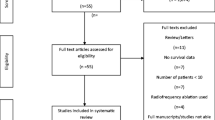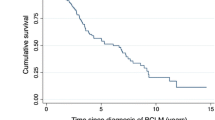Summary
Introduction
Breast cancer patients developing liver metastases have traditionally been considered to make up a poor prognosis group with median survival rates of less than 6 months. We retrospectively analysed clinicopathologic characteristics of 500 women with metastatic breast cancer and liver deposits upon administration of first-line chemotherapy in the 90s. We sought to examine the epidemiology, clinical course, outcome and prognostic factors of this cohort with the hope to identify changing patterns, facilitate cost-effective follow-up and rationalize therapy of these patients.
Materials and methods
Among 1426 metastatic breast cancer patients enrolled with the Hellenic Cooperative Oncology Group (HeCOG) chemotherapy registry from 1988 to 2004, 500 (35%) had liver deposits when first-line chemotherapy was administered and were the subject of this retrospective analysis. These patients had been treated with single-agent or combination chemotherapy either in the context of clinical trials or outwith trials according to standard HeCOG protocols.
Results
Median age at diagnosis was 54.5 years, with the majority of women being fit (Performance Status PS 0–1 76%), postmenopausal (53%) harbouring hormone-receptor positive (54%) invasive ductal, lobular or mixed carcinomas (76%). High-grade tumours were present in 35% of patients, while the extent of systemic relapse was confined to the liver plus none or one additional organ site in 59% of women. Half of the patients had received adjuvant chemotherapy and two-thirds relapsed later than 12 months from initial diagnosis of localized disease. First-line palliative chemotherapy included an anthracycline and/or a taxane in 88% of cases with an objective response rate of 34% (95% Confidence Interval CI: 29.1–37.5), while 79% of patients were able to proceed to second-line chemotherapy based mostly on non-anthracycline non-taxane containing regimens with objective responses seen in 16% of them (95% CI: 11.6–21.9). At a median follow-up of 47.5 months, disease progression occurred solely in the liver in one-third of patients and median overall survival was 16.3 months, with projected 5-year survival of 8.5%. Type of palliative chemotherapy was not a predictive factor for response, though non-anthracycline non-taxane regimens were associated with lower tumour regression rates. Positive hormonal receptor status of the primary, low histological grade, malignant relapse in the liver only or liver plus one organ site and good performance status were significant prognostic factors for improved outcome in univariate analysis, the latter two retaining significance in multivariate analysis as well.
Conclusions
In comparison to historical series, adjuvant therapy, stricter follow up and imaging technology advances result in earlier diagnosis of fitter breast cancer patients with low-volume hepatic and systemic relapse. Cost-effectiveness of close monitoring for early diagnosis of relapse should be further studied. With availability of effective modern chemotherapy, prolonged survival is feasible and aggressive multidisciplinary management of selected patients may be warranted.
Similar content being viewed by others
References
Zinser JW, Hortobagyi GN, Buzdar AU, Smith TL, Fraschini G, 1987 Clinical course of breast cancer patients with liver metastases J Clin Oncol 5: 773–782
O`Reilly SM, Richards MA, Rubens RD, 1990 Liver metastases from breast cancer: the relationship between clinical, biochemical and pathological features and survival Eur J Cancer 26: 574–577
Hoe AL, Royle GT, Taylor I, 1991 Breast liver metastases-incidence, diagnosis and outcome J R Soc Med 84: 714–716
Fumoleau P, 1996 Treatment of patients with liver metastases Anticancer Drugs 7(Suppl 2): 21–23
Paridaens R, Biganzoli L, Bruning P, et al. 2000 Paclitaxel versus doxorubicin as first-line single-agent chemotherapy for metastatic breast cancer: a EORTC randomized study with cross-over J Clin Oncol 18: 724–733
Biganzoli L, Cufer T, Bruning P, et al. 2002 Doxorubicin and paclitaxel versus doxorubicin and cyclophosphamide as first-line chemotherapy in metastatic breast cancer: the EORTC 10961 multicenter phase III trial J Clin Oncol 20: 3114–3121
Chan S, Friedrichs K, Noel D, et al. 1999 Prospective randomized trial of docetaxel versus doxorubicin in patients with metastatic breast cancer. The 303 Study Group J Clin Oncol 17: 2341–2354
Miller KD, Wang M, Gralow J et al.: E2100: a randomized phase III trial of paclitaxel versus paclitaxel plus bevacizumab as first-line therapy for locally recurrent or metastatic breast cancer. Proc Am Soc Clin Oncol late-breaking abstr., 2005
Kelly K, 2003 The benefits of achieving stable disease in advanced lung cancer Oncology 17: 957–963
Nabholtz JM, Reese DM, Lindsay MA, Riva A, 2002 Docetaxel in the treatment of breast cancer: an update on recent studies Semin Oncol 29(Suppl 12): 28–34
Castiglione-Gertsch M, Johnsen C, Goldhirsch A, 1994 The International (Ludwig) Breast Cancer Study Group Trials I–IV: 15 years follow up Ann Oncol 5: 717–724
Atalay G, Biganzoli L, Renard F, Paridaens R, Cufer T, et al. 2003 Clinical outcome of breast cancer patients with liver metastases alone in the anthracycline–taxane era: a retrospective analysis of two prospective, randomized metastatic breast cancer trials Eur J Cancer 39: 2439–2449
Author information
Authors and Affiliations
Corresponding author
Rights and permissions
About this article
Cite this article
Pentheroudakis, G., Fountzilas, G., Bafaloukos, D. et al. Metastatic breast cancer with liver metastases: a registry analysis of clinicopathologic, management and outcome characteristics of 500 women. Breast Cancer Res Treat 97, 237–244 (2006). https://doi.org/10.1007/s10549-005-9117-4
Received:
Accepted:
Published:
Issue Date:
DOI: https://doi.org/10.1007/s10549-005-9117-4




